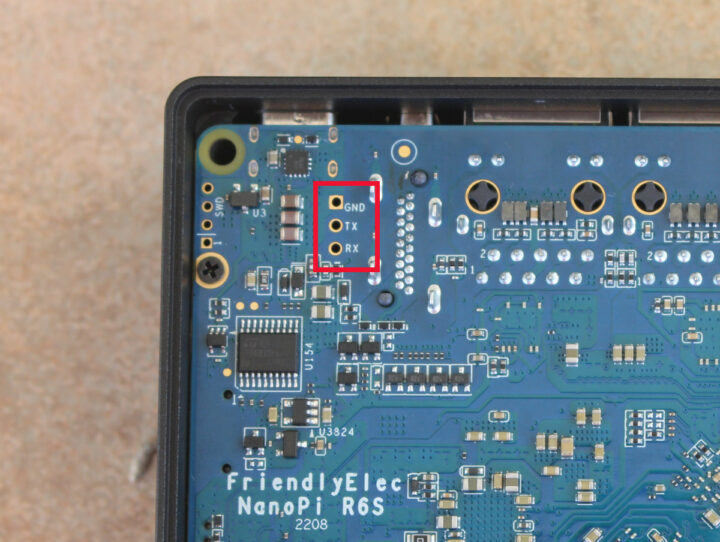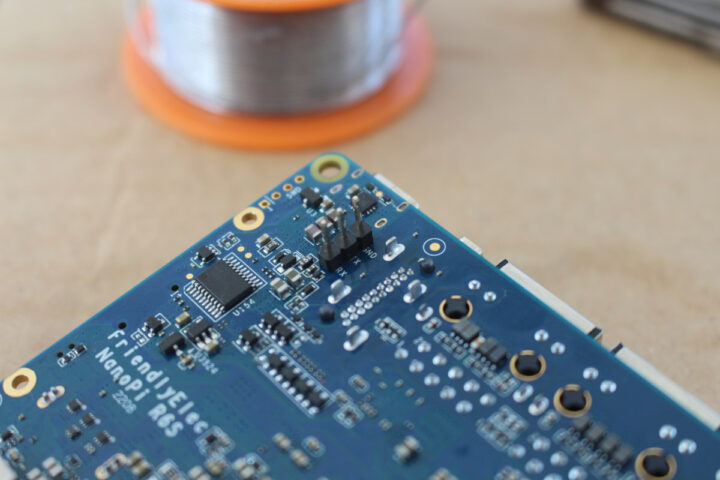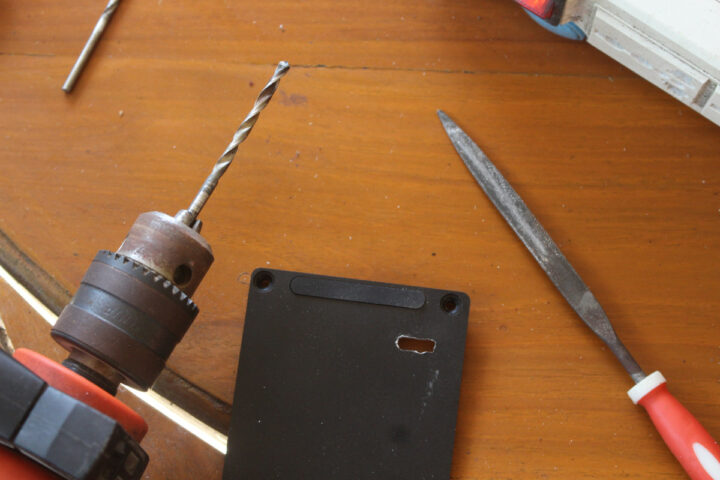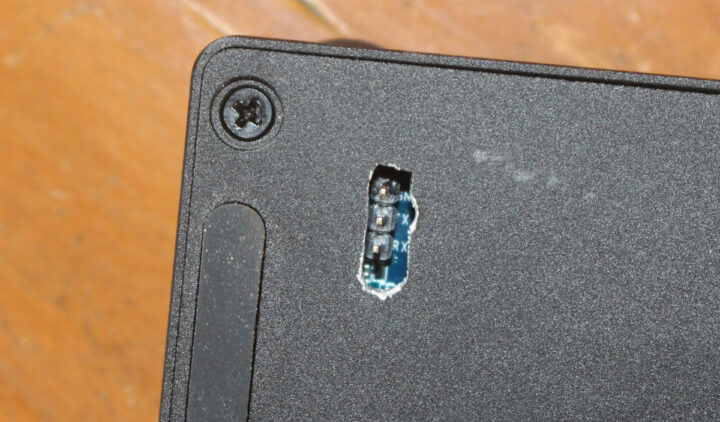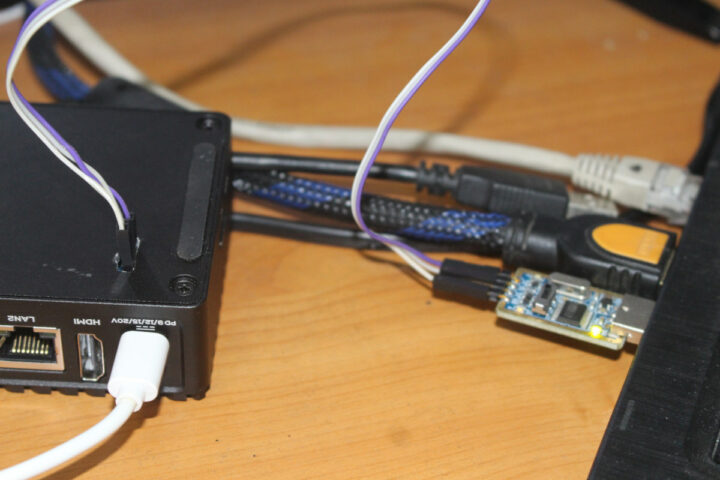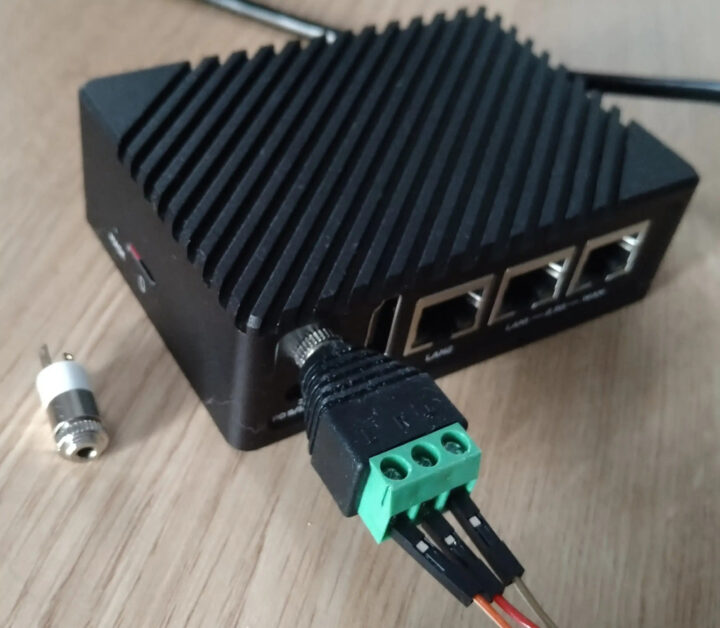I had no trouble with my first experience with NanoPi R6S while installing and running the FriendlyWrt/OpenWrt 22.03 image, but that was another story when testing Ubuntu or Debian as the mini PC would not boot at all after flashing the images with eFlasher apparently successfully, but suspiciously fast (under 2 seconds).
I spent nearly four hours trying the different images and then the Rockchip Windows utility, but all my attempts failed, and FriendlyElec was not overly helpful. So I decided to connect a serial console to see what was going on. The NanoPi R6S comes with a 3-pin header for the serial console, but it’s not populated.
So I soldering one, but not at the top of the bottom, and instead at the bottom since it would allow me to still use the metal enclosure to cool the processor.
Some readers, or at least one, often complain about the lack of external access to the serial console in routers to debug issues without having to disconnect the device and open it up. But with the NanoPi R6S, it’s fairly easy to create to add an external serial console port by soldering the header on the bottom side of the board and then making a hole in the bottom plate.
I used a power drill and a file tool, and the result is functional but not exactly neat. People with better skills than me or a CNC machine could make something neater.
I’ll also pretend I did not center the hole on purpose in order to be able to see the markings (GND, Tx, Rx).
But it does the job and we can now access the serial console without having to tear down the router, simply connect Tx, Rx, and GND to a USB to TTL debug board with jumper wires and we are good to go. I had to cut the headers by about 1 mm to prevent them from touching the desk once we are not using the serial console anymore. A plastic cover would be nice, and looking around in my office, plastic bits covering HDMI cables seem to be good candidates for this purpose, provided we make a hole of the right size.
It works within the eFlasher utility or when I boot the FrienlyWrt/OpenWrt image using 1,500,000 bps baudrate stipulated in the wiki:
|
1 2 3 4 5 6 7 8 9 10 11 12 13 14 15 16 17 18 19 20 21 22 23 24 25 26 27 28 29 30 31 32 33 34 35 36 37 38 39 40 41 42 43 44 45 46 47 48 49 50 51 52 53 54 55 56 |
jaufranc@cnx-laptop-4:~$ bt -b 1500000 No port specified, using ttyUSB0 (last registered). Use -l to list ports. Trying port ttyUSB0... Connected to ttyUSB0 at 1500000 bps. Escape character is 'Ctrl-]'. Use escape followed by '?' for help. DDR Version V1.08 20220617 LPDDR4X, 2112MHz channel[0] BW=16 Col=10 Bk=8 CS0 Row=16 CS1 Row=16 CS=2 Die BW=16 Size=2048MB channel[1] BW=16 Col=10 Bk=8 CS0 Row=16 CS1 Row=16 CS=2 Die BW=16 Size=2048MB channel[2] BW=16 Col=10 Bk=8 CS0 Row=16 CS1 Row=16 CS=2 Die BW=16 Size=2048MB channel[3] BW=16 Col=10 Bk=8 CS0 Row=16 CS1 Row=16 CS=2 Die BW=16 Size=2048MB Manufacturer ID:0x1 Samsung CH0 RX Vref:31.7%, TX Vref:20.8%,19.8% CH1 RX Vref:32.7%, TX Vref:18.8%,18.8% CH2 RX Vref:30.7%, TX Vref:20.8%,20.8% CH3 RX Vref:31.7%, TX Vref:20.8%,20.8% change to F1: 528MHz change to F2: 1068MHz change to F3: 1560MHz change to F0: 2112MHz out U-Boot SPL board init U-Boot SPL 2017.09-g70503fb4d6-220928 #root (Oct 13 2022 - 18:11:22) unknown raw ID 0 0 0 unrecognized JEDEC id bytes: 00, 00, 00 Trying to boot from MMC2 Trying fit image at 0x4000 sector ## Verified-boot: 0 ## Checking atf-1 0x00040000 ... sha256(806278dba1...) + OK ## Checking uboot 0x00200000 ... sha256(2972509ab3...) + OK ## Checking fdt 0x0032ca68 ... sha256(e936f08b25...) + OK ## Checking atf-2 0x000f0000 ... sha256(c00c7fd75b...) + OK ## Checking atf-3 0xff100000 ... sha256(71c3a5841b...) + OK ## Checking atf-4 0xff001000 ... sha256(2301cf73be...) + OK ## Checking optee 0x08400000 ... sha256(fde0860845...) + OK Jumping to U-Boot(0x00200000) via ARM Trusted Firmware(0x00040000) Total: 280.498 ms INFO: Preloader serial: 2 NOTICE: BL31: v2.3():v2.3-405-gb52c2eadd:derrick.huang NOTICE: BL31: Built : 11:23:47, Aug 15 2022 INFO: spec: 0x13 INFO: ext 32k is valid INFO: GICv3 without legacy support detected. INFO: ARM GICv3 driver initialized in EL3 INFO: system boots from cpu-hwid-0 INFO: idle_st=0x21fff, pd_st=0x11fff9, repair_st=0xfff70001 INFO: dfs DDR fsp_params[0].freq_mhz= 2112MHz INFO: dfs DDR fsp_params[1].freq_mhz= 528MHz INFO: dfs DDR fsp_params[2].freq_mhz= 1068MHz INFO: dfs DDR fsp_params[3].freq_mhz= 1560MHz INFO: BL31: Initialising Exception Handling Framework INFO: BL31: Initializing runtime services INFO: BL31: Initializing BL32 INFO: hdmirx_handler: dma not on, ret I/TC: I/TC: OP-TEE version: 3.13.0-652-g4542e1efd #derrick.huang (gcc version 10.2.1 20201103 (GNU Toolchain for the A-profile Architecture 10.2-2020.11 (arm-10.16))) #5 2022年 09月 20日 星期二 09:41:09 CST aarch64 |
But there’s no output at all with Ubuntu or Debian. So something must be wrong while flashing the image inside the eFlasher utility especially since it just takes one or two seconds to complete the “firmware upgrade”, I’m guessing some issues with the MicroSD card (I/O errors or too small), but that will be for another day.
I hope FriendlyElec considers providing easy access to the serial console in their future routers, as it should cost close to nothing to implement a solution as described above.
[Update: Pastrav has come up with a nicer way to add a serial port to NanoPi R6S using a 2.5mm audio connector attached to the hole reserved for an antenna. See comments for details.
]
This is it for the 10,000th post published on CNX Software!

Jean-Luc started CNX Software in 2010 as a part-time endeavor, before quitting his job as a software engineering manager, and starting to write daily news, and reviews full time later in 2011.
Support CNX Software! Donate via cryptocurrencies, become a Patron on Patreon, or purchase goods on Amazon or Aliexpress


